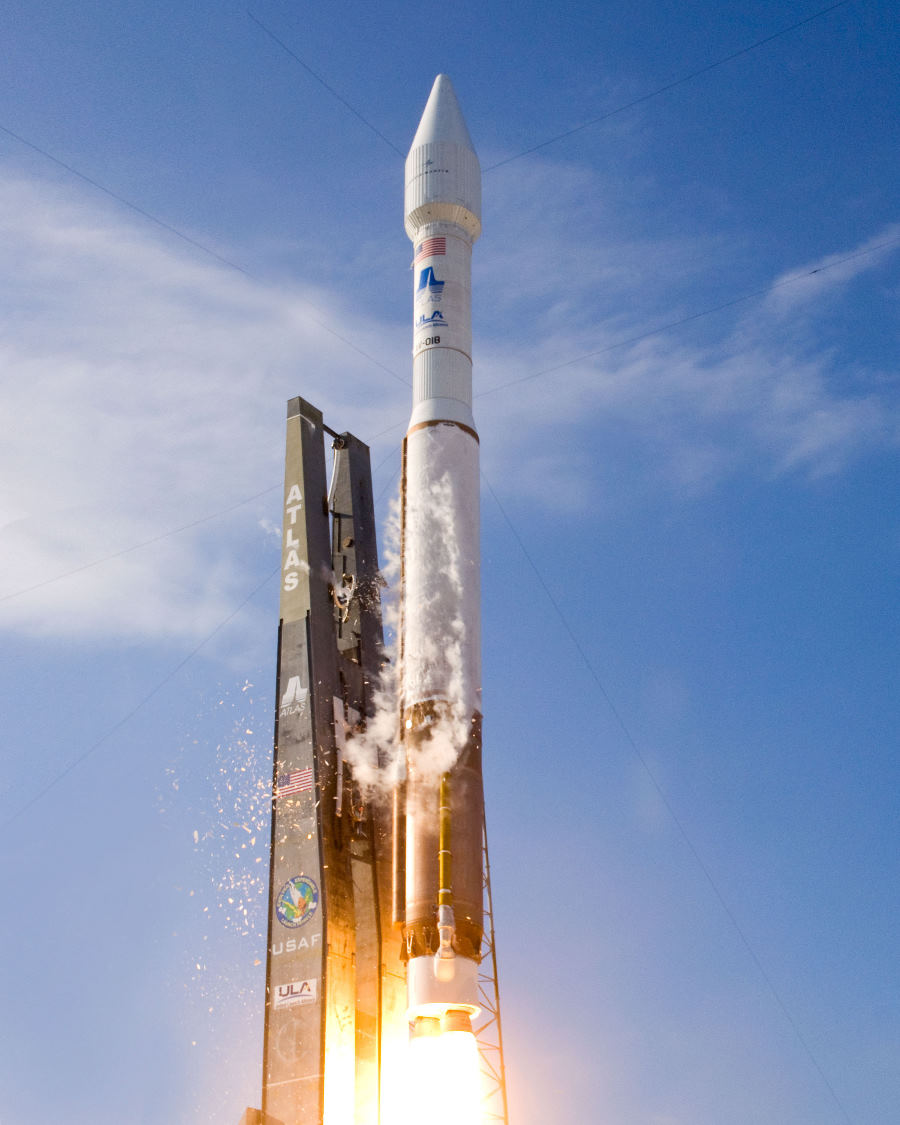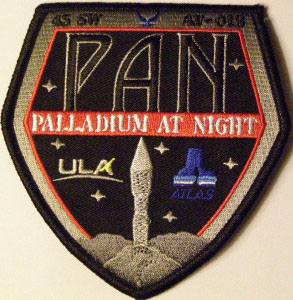 |
||
|
|
||
|
Lifting Government Communications Satellite ..
A United Launch Alliance Atlas
V rocket with the PAN satellite launches from Space Launch Complex-41 at
5:35 p.m. EDT today. ULA launched PAN on behalf of the Lockheed Martin
Space Systems Company. (Photo by Pat Corkery, United Launch Alliance)
45th Space Wing Launches Atlas V Lifting Government Communications Satellite Posted 9/9/2009
9/9/2009 - CAPE CANAVERAL AIR FORCE STATION, Fla. -- The 45th Space Wing launched successfully a United Launch Alliance-built Atlas V Evolved Expendable Launch Vehicle from Space Launch Complex 41 at 5:35 p.m. (EDT) today. The Atlas V rocket carried a U.S. government communications
satellite into space.
"The 45th Space Wing is in the midst of a very busy launch season and during our Operational Readiness Inspection. We are looking forward to many more successful missions before the year's end," General Bolton said. "This is perhaps the cleanest countdown we've seen this year." This mission was the 16th flight of an Atlas V rocket from here and the 13th launch overall this year on the Eastern Range. "This launch was an outstanding achievement for the entire Atlas team," said Staff Sgt. Brad Tavares, Atlas V Mission Assurance Technician. "It makes me extremely proud to be a part of the success of this mission and I look forward to providing continued mission assurance for all future launches." Contact: 45th Space Wing Public Affairs, 321-494-5933 or 45swpa@patrick.af.mil SOURCE: Patrick AFB Press Release |
||
|
... |
||
|
..
ULA - United Launch Alliance
|
||
Related Links:
|
||
|
Atlas V Successfully Launches PAN Satellite Klaus Schmidt On: 09 September 2009 8:39 AM Cape Canaveral, Fla., (ULA) – A United Launch Alliance Atlas V rocket, on behalf of the Lockheed Martin Space Systems Company, successfully launched the PAN satellite at 5:35 p.m. EDT, today from Space Launch Complex-41 as a commercial launch service. This launch marks the 10th overall mission for ULA in 2009 and the third Atlas V mission of the year. “ULA is proud to have played a critical role in the success of this important mission,” said Mark Wilkins, ULA vice president of Atlas programs. “Close teamwork with Lockheed Martin and the U.S. Air Force’s 45th Space Wing at Cape Canaveral made today’s launch possible.” This mission was launched aboard an Atlas V 401 configuration and used a single common core booster powered by the RD-180 engine and a single engine Centaur upper stage. The launch portion of the mission was completed with spacecraft separation approximately two hours after launch. ULA’s next launch, currently scheduled for no earlier than Sept. 18, is the STSS Demo satellite for the United States Missile Defense Agency aboard a Delta II rocket from Space Launch Complex-17B here. SOURCE: spacefellowship.com |
||
|
Atlas V launches classified PAN satellite for US Government September 8th, 2009 A United Launch Alliance Atlas V rocket has launched with PAN, a classified satellite which will be operated by the US Government. The launch was on time, at the start of a two hour, nine minute launch window which opened at 21:35 GMT (17:35 local time). Unusually for an American government satellite, the agency responsible for operating the spacecraft has not been disclosed. Preview: PAN, which officially stands for “Palladium At Night”, is also known as P360. It is a communications satellite, which was built by the Special Programs division of Lockheed Martin Space Systems. The satellite was constructed under a fixed-price,
in-orbit delivery contract; meaning that Lockheed Martin is responsible
for arranging launch services, and operating the satellite until it reaches
its operational orbit. Because Lockheed Martin is the customer for the
rocket rather than the US Government, the launch is officially considered
to be commercial.
* LIVE Atlas V/PAN UPDATES
PAN was built around the A2100 satellite bus, and is reported to use commercial off-the-shelf components. The A2100 satellite bus was developed in the early to mid 1990s. The first A2100 to be launched was GE-1, which flew in June 1996. Most such satellites have a design life of fifteen years. The contract to construct PAN was awarded in October 2006, with launch initially expected 30 months later, however it has since slipped a few months – mostly due to knock-on delays from earlier Atlas launches. The orbit into which PAN will be launched has not been officially confirmed, however maps of the launch hazard area for the flight show that it will follow an azimuth usually associated with launches to equatorial orbits. As it is a communications satellite, it is therefore almost certain to be deployed into a geosynchronous transfer orbit, from which it will subsequently raise itself into a geostationary orbit. Typical A2100 satellites use LEROS-1C apogee motors to perform this manoeuvre. PAN will lift off from Cape Canaveral’s Space Launch Complex 41; a launch complex which was originally built for the Titan IIIC rocket in the 1960s. It was first used in December 1965. During the mid 1970s, Titan IIIE rockets, which featured Centaur upper stages, were launched from SLC-41 with spacecraft including the Helios, Viking and Voyager probes. It was then converted for the Titan IV, which made its maiden flight from the complex in 1989. The final Titan launch from the complex occurred in April 1999, and ended in failure when the upper stage malfunctioned. Later the same year, the pad’s towers were levelled in controlled explosions. Following conversion work, the Atlas V made its maiden flight from the complex in 2002. Atlas V rockets are assembled in the Vertical Integration Facility, about 550 metres south of the launch pad, and are subsequently rolled out atop a mobile platform. AV-018, which will be used to launch PAN, departed the VIF at 14:06 GMT on 7 August, taking around half an hour to reach the pad. The countdown is scheduled to begin at 14:25 GMT Tuesday; five hours and ten minutes before the opening of the launch window. An Atlas V 401 rocket will be used to conduct the launch; a configuration which consists of a single Common Core Booster first stage with no strap-on solid rocket motors, a Centaur upper stage powered by a single engine, and a payload fairing with a diameter of four metres. For this flight, a Large Payload Faring (LPF) will be used. This was originally developed for the Atlas III, and has a length of twelve metres. Despite its name, it is the shortest payload faring available for the Atlas V. The Centaur has been painted white in order to provide better thermal protection during the coast phase of the flight than is provided by the usual orange-coloured variant. The first stage will be powered by a Russian RD-180 engine, developed by NPO Energomash. It will ignite 2.7 seconds before launch, burning RP-1 propellant in liquid oxygen. At T-0 seconds, the rocket will be released from the launch pad and begin its ascent towards orbit. Seventeen seconds into the flight, it will begin manoeuvring to the correct attitude to achieve its target orbit. Seventy-nine seconds after launch, the rocket will be travelling at Mach 1, and twelve seconds later it will pass through the area of maximum dynamic pressure, max-Q. Four minutes and three seconds after lifting off, the first stage will cut off, having depleted its fuel. Six seconds later it will be jettisoned with the aid of eight retro-rockets, and following a further ten seconds of coasting the Centaur’s RL10A engine will ignite for the first of two burns. The RL10A was developed by Pratt and Whitney Rocketdyne, and burns cryogenic propellants – liquid hydrogen and oxygen. Eight seconds after the Centaur ignites the payload faring will separate, and at this point official updates on the status of the launch will be discontinued. Seventeen minutes and twenty seven seconds after launch, the RL10A engine will shut down, completing the thirteen-minute and eight-second first burn. Shortly thereafter, it will be reoriented to a more suitable attitude for the coast phase of the mission, which will last for almost 100 minutes. At the end of the coast phase, the Centaur will again be reoriented, this time for main engine start. The Centaur will restart for its second and final burn one hour, fifty five minutes and ten seconds after launch. The burn will last one minute and twenty six seconds, and will be followed by the upper stage reorienting for spacecraft separation. One hour, fifty nine minutes and twenty five seconds after lifting off, PAN will separate from the carrier rocket. This will be the seventeenth launch of an Atlas V rocket, and the eighth to use the 401 configuration. It is also the third Atlas launch of 2009. The next Atlas launch is scheduled to occur from Vandenberg AFB towards the end of the month, carrying a DMSP weather satellite into low Earth orbit. The exact date for that launch is currently unclear, but is likely to be either 23 or 25 September. Before that, ULA will use a Delta II rocket flying from Cape Canaveral to orbit the two STSS Demo satellites. The Delta launch is currently scheduled for midnight GMT on 18 September, and is being flown under a contract with NASA. SOURCE: NASA Spaceflight.com |
||
|
Satellite Imagery: Ikonos Pan ...
Information Ownership & Access Space Imaging was founded in December, 1994 in Denver, USA and owns the IKONOS satellite. Although military imagery from satellites at close to one-metre resolution has been available on a classified basis, IKONOS is the first one-metre satellite to be commercially available to the public. The IKONOS satellite system was built by Lockheed Martin
Commercial Space Systems. The communications, image processing and customer
service elements were built by Raytheon Company while the camera was built
by Eastman Kodak. The satellite was launched aboard a four-stage Lockheed
Martin Athena 11 launch vehicle from the Vandenberg Air Force Base in California,
USA. IKONOS imagery is received from Space Imaging.
Space Imaging launched the worlds first, and currently
only, one-metre resolution, commercial satellite, IKONOS, on 24 September,
1999. Since its successful launch, high resolution imagery has been and
is still available to the commercial sector. The anticipated life-span
of the IKONOS satellite is between five and seven years.
IKONOS has a sun-synchronous, near polar orbit which is repetitive, thereby ensuring a full coverage of the entire earth. IKONOS orbits the earth at 681 kms and circles the earth fourteen times a day, once every 98 minutes, on a north-south axis. IKONOS has the ability to collect 20000 km2 in a single pass. The sensor can be inclined to acquire imagery up to 700 km on either side of the track (off-nadir viewing capacity), giving the satellite the capacity to revisit any area on the earth every 1.5 days, albeit with different sensor angles or resolution. The satellite repeats the exact same orbit every 35 days. IKONOS produces panchromatic (black and white) imagery
at one-metre resolution and multispectral (colour) imagery at four-metre
resolution. In a one-metre panchromatic image, objects that are one metre
in size on the ground can be distinguished, providing they have separate
and distinct visual characteristics from other neighbouring objects. For
example, objects such as swimming pools, cars, boats and tennis courts
are all recognisable because of their context within their surroundings.
White stripes in parking lots are also visible because of their sharp contrast
with the black asphalt. Multispectral four-metre imagery does not have
the spatial clarity of the panchromatic imagery due to its lower resolution
however the four-metre multispectral imagery has a much higher spectral
resolution due to its four bands in the blue, green, red and near-infrared
part of the spectrum. This higher spectral resolution allows the user greater
scope for distinguishing between vegetation and soil types and other land
use and landcover applications.
Imagery from IKONOS is available in 11 bits per pixel. However since many remote sensing software systems are unable to cope with 11 bit data, it is possible to obtain high resolution imagery from IKONOS in 8 bit data form. The panchromatic imagery is available in one band which has a spectral wavelength from 0.45 to 0.9 µm while the multispectral imagery is available in four bands in the blue, green, red and near-infrared part of the spectrum and also ranges from 0.45 to 0.9 µm. Data from IKONOS with one-metre panchromatic and four-metre multispectral resolution is useful for a variety of applications, of which these are some of the most important: Cartography. One-metre panchromatic data are ideal for mapping to very high scales, up to 1:5000. In areas where ground surveys are difficult to carry out, due to difficult terrain or political boundaries, mapping using one-metre imagery is particularly useful. In addition, Digital Elevation Models (DEM's) can be constructed from stereo pairs for 3D visualisation. Defence. A variety of defence applications, for example: Mapping, Strategic Target Detection, Demining and Mission Planning and Training, can be enhanced by using one-metre satellite imagery. Urban Planning. Cadastre updating, particularly in rural areas but also in urban areas, is made easier using one- or four-metre satellite imagery. High resolution imagery is used for positioning pipelines and powerlines, rubbishdumps and dams. Agriculture. The detail for precision farming can be provided by one- and four-metre imagery. Insurance. One-metre imagery can be used for property
damage control and the verification of crop damage, for example: hail,
drought and frost.
High resolution IKONOS imagery is available are various levels of correction, including Path, Map and Ortho levels. This imagery has a range of different accuracies depending on the product ordered. The coarsest level of accuracy is the Geo level which is accurate to 1:50 000 while Precision Plus imagery is accurate to up to 1:2400 scale. SOURCE: IKONOS PAN |
||
| United Launch Alliance (ULA)
United Launch Alliance (ULA), formed in December 2006, is a joint venture owned by Lockheed Martin and The Boeing Company. The combined Atlas and Delta teams provide spacecraft launch services for the U.S. government. U.S. government launch customers include the Department of Defense, NASA, the National Reconnaissance Office and other organizations. Atlas and Delta expendable launch vehicles have supported space programs for more than 50 years, carrying a variety of payloads including weather, telecommunications and national security satellites that protect and improve life on Earth, as well as deep space and interplanetary exploration missions in support of scientific research. Three families of launch vehicles – Delta II, Delta IV and Atlas V – continue to support strategic U.S. space initiatives. ULA program management, engineering, test and mission support functions are headquartered in Denver, Colo. Manufacturing, assembly and integration operations are located at Decatur, Alabama, and Harlingen, Texas. Launch operations are located at Cape Canaveral Air Force Station, Florida, and at Vandenberg Air Force Base, California. History Boeing and Lockheed Martin announced their intent to form the United Launch Alliance joint venture on May 2, 2005. The joint venture merges the production of both of their government space launch services into one central plant in Decatur, Alabama and all engineering into another central plant in Littleton, Colorado. Boeing Integrated Defense Systems Delta IV and Lockheed Martin Space Systems Atlas V are both launchers developed for the Evolved Expendable Launch Vehicle program intended to provide the United States government with competitively priced private spaceflight and assured access to space. SpaceX challenged the antitrust legality of the launch services monopoly on October 23, 2005. SpaceX is interested in competing for government launch contracts with the Falcon 9 rocket. On January 7, 2006 the Department of Defense gave preliminary approval to the United Launch Alliance while the Federal Trade Commission had yet to issue a final decision. In September 2006, the Pentagon renewed their support for a United Launch Alliance. The Pentagon announced their support to the Federal Trade Commission (FTC), who gave their anti-trust clearance on October 3, 2006. The joint venture received final approval from the Federal Trade Commission and began operations on December 1, 2006. ULA is expected to bring an estimated 230 jobs to the Decatur Metropolitan Area. On June 15, 2007, the engine in the Centaur upper stage of a ULA-launched Atlas V shut down early, leaving its payload – a pair of NRO L-30 ocean surveillance satellites – in a lower than intended orbit.[2] The anomaly caused delays to forthcoming Atlas V and Delta IV launches, due to the common RL-10 upper stage engines. The fault was traced to a new type of valve being used in place of an older component which had gone out of production. To resolve the problem, the older design will be put back into production, and in the meantime, surplus valves from the original production run will be used. SOURCE: Wikipedia United_Launch_Alliance |
||
| NRO Shortfall May Delay Upcoming
ULA Missions
Jun 22, 2007
The June 15 shortfall of a United Launch Alliance (ULA) Atlas V launch vehicle with a pair of classified National Reconnaissance Office (NRO) ocean surveillance spacecraft onboard may delay upcoming military missions by the Boeing/Lockheed Martin joint venture. Among them could be the first Boeing-built Wideband Gapfiller System (WGS) satellite, designed to begin replacing the aging Defense Satellite Communications Spacecraft (DSCS) constellation. Speaking to the Washington Space Business Roundtable, ULA chief operating officer Dan Collins said June 21 that his company has launched an investigation into the anomaly. The Pratt & Whitney Rocketdyne RL-10 engine in its Centaur upper stage shut down early, leaving the NRO L-30 payloads in slightly lower altitudes and inclinations than desired (DAILY, June 18). "We did have an in-flight anomaly, which we have a review, [an] anomaly review team active right now, [to] understand just what happened and what's going on," Collins said, adding that he was personally involved in "making sure everybody on the team is focused on understanding this." As to the shortfall's impact on future missions, "at this point in time it's really too early to tell," Collins said. "We have the plans in place to continue, and we will look at the right times as to whether it's the right move to take the next step," he said. The U.S. Air Force also is expected to order a review of the failure, which one former military intelligence officer with knowledge of the program called "a major blow, major disappointment." In addition to the WGS launch on an Atlas V from Cape Canaveral AFS in August, other ULA national security missions that might be affected by a prolonged anomaly review include another NRO launch from the Cape in October and perhaps the unscheduled first Atlas V flight from Vandenberg AFB, Calif., which will also carry an NRO payload. SOURCE: Aviation Week |
||
| FAIR USE NOTICE: This page contains copyrighted material the use of which has not been specifically authorized by the copyright owner. Pegasus Research Consortium distributes this material without profit to those who have expressed a prior interest in receiving the included information for research and educational purposes. We believe this constitutes a fair use of any such copyrighted material as provided for in 17 U.S.C § 107. If you wish to use copyrighted material from this site for purposes of your own that go beyond fair use, you must obtain permission from the copyright owner. | ||
|
|




